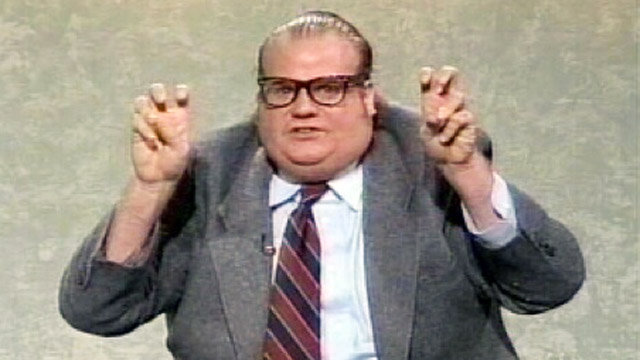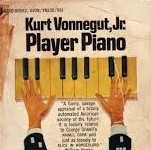 In a movie, a character can use “air quotes” to punctuate his or her lines, as has been done countless times in dozens of films. TV sitcoms and comedy shows use “air quotes” with abandon as well. Jon Stewart of “The Daily Show” uses both air quotes and scare quotes, but he refers to the latter as ”dick quotes”—and he’ll have to explain that one!
In a movie, a character can use “air quotes” to punctuate his or her lines, as has been done countless times in dozens of films. TV sitcoms and comedy shows use “air quotes” with abandon as well. Jon Stewart of “The Daily Show” uses both air quotes and scare quotes, but he refers to the latter as ”dick quotes”—and he’ll have to explain that one!
But how to perform an “air quote” in print, in a newspaper article or a blog post online? Well, the body language is a bit different, and one uses a keyboard rather than one’s outstretched fingers in a rabbit-eared stare, but the effect can be the same. For some odd reason, nobody on Earth has yet figured out why these printed “air quotes” have been dubbed “scare quotes.” There are neither scary nor frightening, although their unregulated use online and in print now is a bit discombobulating, to be sure..
I once asked the artist Peter Plagens, who was travelling in Italy when our emails met in cyberspace, what he knew about scare quotes, since scholars have noted that he was the first American to use the term in print in a non-academic publication. Yes, in a 1993 article for Newsweek about Roy Lichtenstein’s art, Plagens used the scare quotes term in print for the first time ever in popular culture (unless Al Gore beat him to it!).
When I asked Peter how the term first came to him, he replied:
“I first heard the term ‘scare quotes’ in the late 1980s when I’d just become art critic at Newsweek magazine. Overly fond of every device available—parentheses, em-dashes, semi-colons, italics, etc.—that might give a little bounce to what I wrote, I used scare quotes a lot, without, of course, knowing their name. Then an editor told me to quit using so many scare quotes. What are they, I asked, and was told the ‘name’ of the thing I should quit using so much.”
 But the term took on a life of its own post-Plagens. From the “august” New York Times to “edgy” CapitalNewYork, from the “Moonie” Washington Times to the New Republic and New York magazine, scare quotes have been on a roll ever since, and there’s seemingly no end in sight.
But the term took on a life of its own post-Plagens. From the “august” New York Times to “edgy” CapitalNewYork, from the “Moonie” Washington Times to the New Republic and New York magazine, scare quotes have been on a roll ever since, and there’s seemingly no end in sight.
I’m surprised there isn’t a board game about scare quotes or even an online game based on them. What’s next? “Square Quotes” the movie? ”Sponge Bob Scare Quotes” the TV show?
According to “sources,” the original term might have been ”coined” sometime in the 1950s in an academic setting that mostly revolved at first around philosophy professors in Britain. In addition to being called ”scare quotes,” other names have been tossed around, including ”sneer quotes,” ”horror quotes” and ”distancing quotes” (not to mention Jon Stewart’s unfortunate coinage, above).
I myself had never really paid “serious” attention to the “scare quotes” term until I began seeing it everywhere in print—and online—over the past few years. One day, I just couldn’t take it anymore. Enough with these scare quotes! Why on Earth are they called ”scare” quotes?
The Chicago Manual of Style cautions against their overuse, noting:
“Quotation marks are often used to alert readers that a term is used in a nonstandard, ironic, or other special sense and imply ‘This is not my term’ or ‘This is not how the term is ‘usually’ applied.’ Like any such device, scare quotes lose their force and irritate readers if overused.”
I sometimes wonder what Steve Martin, who invented “air quotes” back in the 1980s, would have to say about scare quotes.
Could the nickname be any reference to “scarecrows,” perhaps, as some ”pundits” have suggested?
When I asked a Stanford University language man about this, he told me by email that he had come across two academic references to scare quotes that date as far back as 1956 and 1960, and from England, no less. A British scholar sent me a 1946 reference to the term in a non-fiction book by Upton Sinclair. 1946!
I’m looking for the “first coiner” of the ‘scare quotes’ term. If the “late” William Safire was alive, I would ask him.
All I know is that if you Google the phrase today you will find “scare quotes” all over the place, from newspaper pieces to blog posts. There’s even a book and a website devoted to “scare quotes” now, with photos posted of humorous office and lawn signs depicting them.
Colin Fine in Britain has offered me this consolation:
“It’s very rare to be able to pinpoint the individual who first used a word in a particular meaning, and equally rare to be able to do more than speculate about exactly what mental picture or association they had when they made that innovation.”
I hate to go to Wikipedia, but here goes: “Scare quotes are quotation marks placed around a word or phrase to ”imply” that it may not ”signify” its ”apparent” meaning, or that it is not ”necessarily” the way the quoting person would ”express” its concept.”
Got that? I haven’t a clue.


































Tracking down the origins of phrases is a lot easier in the era of electronic texts and search engines. Somebody with a full-text Hathi Trust account might be able to dig into this. The best I can find is this 1957 reference (skip down to “scare”) from a British philosophical psychology book. Also, you can witness the rise of scare quotes on Google Ngram.
Here’s the 1957 reference.
There’s perhaps some confusion between the use of scare quotes and using that term to describe them. The term is easy to find in digital searches. The first use is much more difficult, particularly since it could involve either single or double quotes. No one wants to look at every use of quotation marks in the last five centuries.
Yesterday I mentioned my own efforts to purge them out of my writing and why they’re usually bad writing. Today, I’ll add another. I regard them as sneer quotes because that’s how they’re often used–to sneer at people the writer dislikes. Much of my disgust for them flows from a dislike for those sneerers. People who think they’re cleverer than most others often aren’t.
The same applies to air quotes. Imagine someone who is speaking but can’t make that hand gesture, perhaps because they are on radio. How would that emulate it. Probably by adopting a sneering (rather than scary) tone of voice, hence my preference for sneer quotes.
I’m not the only one. There’s even a blog dedicated to Sneer Quote Central:
http://sneerquote.blogspot.com
It includes this remark about a recent Reuters use:
****
But I had to make note. Reuters today used sneer quotes around the description of Hitler as a monster. Since he obviously was not, we should assume the news agency believes. A startlingly convincing portrayal of Adolf Hitler in a new German movie about his last 12 days is causing controversy with critics challenging its treatment of the “monster” as a human being. Shouldn’t the ‘startlingly convincing’ be in sneer quotes?
****
Like I said both yesterday and today, most uses of sneer quotes don’t impress me. Better to avoid them an assume your readers aren’t idiots.
Dusk and Michael, above, very good (and informative) comments, thanks to adding to the fray. For the time being, since the term is now so embedded in The Culture, we are stuck with calling them scare quotes, but I would love to see your idea of calling them sneer quotes evolve to become the main term for them. Good idea. Maybe that new website about sneer quotes will help force a change. But until some word maven like Ben Zimmer at Visual Thesaurus or the ghost of William Safire weighs in on all this, we are stick in scare quotes hell for now. They are everywhere, and the term itself is everywhere.
As for air quotes, I met a gentleman in Boston online recently who has created a body language way to use a scare quote (aka sneer quote) with the fingers and he even made a video to show how. Let me look it up in my files: HERE: ”How to do scare quotes as an air quote? Use three fingers in both hands, the three middle fingers on each hand, and do it the same way”
link
http://plogspot101.blogspot.tw/2012/08/how-to-do-scare-quotes-as-air-quote-use.html
On how to voice scare quotes: I hope I’m not mentioning the obvious here, but the convention for a long time has been to simply speak the quotation marks. “She’s a, quote, feminist, unquote.” Or, “She’s a feminist quote unquote.”
From a 1960 book on linguistics:
“[The author] maintains that devices originally used only in the written form are now being introduced into the spoken language. Yes, but with a vengeance. He mentions ‘quote’ – ‘unquote’. Now this very example defies his equation. In writing the form used is ‘X’ (quote-X-unquote) whereas in speech the form X” (X-quote-unquote-) is at least as common . . .”
From a play appearing in a 1965 book:
“Have you ever heard people do that [say ‘quote, unquote’]? My girl puts two fingers out, like this, as if she were scratching the air, and she says . . . ‘I am quote washing unquote my hair.’ It drives me [crazy].”
So the campaign against scare quotes and air quotes has been going on for a while, it seems. 🙂